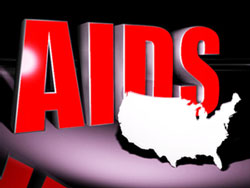- Black groups band together to fight AIDS (FCN, 08-29-2006)
- ‘AIDS is man-made’ – Interview with Dr. Boyd Graves (FCN, 10-05-2004)
- Was AIDS developed by US Government?

(FinalCall.com) – HIV rates are declining in prison, according to the Bureau of Justice, but AIDS activists paint a different picture of the disease’s prevalence both in and out of prison.
Laura M. Maruschak, a statistician for the U.S. Department of Justice Bureau of Justice Statistics, studied statewide HIV rates for 2005 and 2006, and found that the number of HIV positive prisoners decreased by a little more than three percent (from 22,676 to 21,980). Despite this drop, the overall AIDS rate among prisoners was 0.46 percent compared to 0.17 percent for the U.S. general population.
The report, “HIV in Prisons 2006,” further indicated that the number of AIDS-related deaths in state and federal prisons dropped to 167 from 203; and the states with the largest numbers of AIDS related deaths were Florida (28), New York (14), Pennsylvania (13), Georgia (10) and Louisiana (10).
The data does not include information on the flow of HIV positive inmates in and out of prisons, and the Justice Department has no idea of where inmates go when released, but is exploring ways to get that data. There are also times when some states fail to submit year-end data–mostly because states do not have the facilities to track the numbers, Ms. Maruschak told The Final Call.
“The bigger states are the ones that we always try to get no matter what. We force the issue and get some numbers because when a Georgia, Texas or California would drop out, you would see an artificial decrease. If we are talking about a small state reporting a small number, it doesn’t affect the data,” she said.
“The whole service community is saying the numbers are up,” said Cynthia Davis, director of HIV Education & Outreach Programs for the Charles R. Drew University of Medical and Science. Her organization helps service some 15-20 prisons in California and many inmates have no clue of their HIV status because of a lack of mandatory testing of inmates.
“We don’t know what the actual numbers are. At a recent training, a health professional estimated that there are 1,200 people in prisons who are HIV infected, but their internal numbers were upward of 3,000. That’s a big discrepancy and we don’t have a handle on the amount of prisoners in California or nationally who are infected or know their status,” Ms. Davis said.
Ms. Davis supports legislation to test inmates, including Rep. Maxine Waters’ proposed Stop AIDS in Prison Act of 2007, which was introduced last month.
The act would allow for routine non-mandatory HIV counseling and testing upon entry and release and enable prisoners to request testing without being penalized.
“This would help determine numbers more accurately, because often if you’re found to be positive, then you lose a lot of privileges that are afforded non-HIV positive inmates, like certain jobs, housing status and even work time credit. They’ll send you to an institution that primarily cares for people with HIV/AIDS, but once persons are comfortable in an institution they don’t want to move,” Freddie Williams told The Final Call. Inmates also don’t want to extend their stay by losing work time credit if they report their status, he said.
Mr. Williams speaks from experience. He spent 20 years in prisons in Arizona and California and contracted HIV in 1994 as a result of drug abuse. Today, he is an HIV prevention and certified substance abuse counselor in Lancaster, Calif.
AIDS researchers say any decline in numbers is a result of more advanced medications, but federal and state funding needs to target more outreach and education, especially to minority communities.
Despite an increase in new HIV/AIDS diagnoses in 2006 among Whites and Asians/Pacific Islanders, the disease is still more prevalent among Blacks and Latinos. The Centers for Disease Control and Prevention’s 2006 AIDS statistics were:
– Blacks — 67.7 AIDS cases per 100,000;
– Latinos — 25.5 AIDS cases per 100,000;
– Whites–8.2 8.2 AIDS cases per 100,000;
– Asians/Pacific Islanders — 6.7 per 100,000.
“When AIDS first struck, the CDC labeled it ‘G.R.I.D.’ meaning gay-related immunodeficiency disease, and tried to combat it using a social model instead of a medical model; and of course the White gay male population began to get a handle on it through education and funding, but now that it has become a people of color disease, they don’t have any money to fund it,” Mr. Williams said.
“Looking forward we need to begin to mobilize community by community and we need to mobilize through our churches because if we don’t do anything to get a handle on this and recognize that it has become a people of color pandemic, we will be in a world of trouble,” he said.












